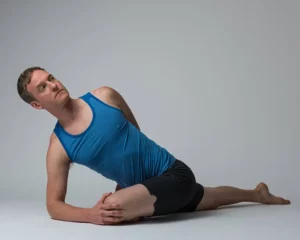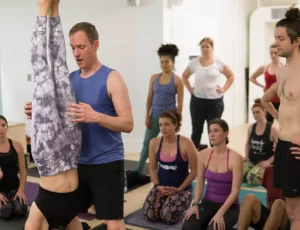Forearm Balance’s similarities to Handstand are striking, In fact, the two postures are identical from the feet all the way through the elbows. The point of differentiation between the postures is that you bend your elbows and place them on the floor in forearm balance and you keep them straight in Handstand. This is obvious to even the most casual observer. What is not obvious is the chain reaction that bending the elbows creates in the shoulders, core, spine, pelvis, and legs. Let’s look at this chain reaction and learn how to work with it.
One quick tip about Forearm Balance (Pincha Mayurasana)
When you bend your elbows in and place them on the floor, it becomes much harder to flex your shoulder joints. This means that most students feel tighter and more restricted in their shoulders in Forearm Balance compared to Handstand. Yes, Forearm Balance has certain advantages that Handstand doesn’t. However, for many students it can be very challenging to get the upper-arms, shoulders, and ribs verticaly stacked in Forearm Balance. When the shoulders don’t flex easily, the core and spine compensate by moving too far into extension. Here’s another way of saying the same thing: when the shoulders don’t flex enough, the spine and core compensate by moving too far into a backbend – so your body is in a banana shape.
So, instead of just focusing on strengthening your core, my tip for this pose is to focus on creating more shoulder flexion by doing three things:
1. Stretch your triceps and lats
2. Stretching your rhomboids and traps
3. Stretching your pecs and anterior deltoids
This sounds like a lot, but it’s not rocket science. The warm-up below lists the postures that work best.
WARM UP
It’s a good idea to warm up your entire body with a few Sun Salutations before you focus on preparing your shoulders. Any kind of salutation will do the trick. Once you’ve done a few rounds, sit on the floor in Sukhasana or Vajrasana. Do the following four shoulder openers:
1) Half-Down Dog (hands on a wall or on a chair), Dolphin Pose, and Gomukhasana to stretch your triceps and lats
2) Cat Pose and Garudasana to stretch your rhomboids and traps
3) Fingers interlaced and arms straight behind your back to stretch your chest and the front of your shoulders.
Handstand is also great all around preparation if it’s part of your repertoire.
HOW TO DO FOREARM BALANCE (PINCHA MAYURASANA)
As with other inversions, it’s helpful to learn this pose at the wall and with the help of a skilled teacher. If you’re more experienced and able to work on balancing in the posture, you’re welcome to follow the same instructions while in the milddle of the room.
1. Set up facing a wall.
2. Place your forearms on the floor with your elbows shoulder-width apart. Your forearms should be parallel to each other and your palms should face down. Adjust your distance from the wall so that the wall is just barely beyond the reach of your fingertips.
3. There are many different ways to use a block in this pose and I’m an advocate for all of them! For the purpose of this blog, I’m simply going to suggest that you place a block between your hands.
More specifically, look at your fingers and place the block so that your index fingers touch the sides of the block and your thumbs touch the bottom of the block.
4. Bring your shoulders forward so that they’re direclty above your elbows. Step one foot half way to your elbow and bend your knee. Choose whichever leg feels the most natural.
5. Root down through the base of each finger and thumb.
6. Look at the floor in between your hands. Take a slow, deep breath. Don’t freak out.
7. As you exhale, bend the knee that you brought forward more deeply and strongly push the floor away. As this leg jumps, simultaneously swing the back leg toward the wall. Keep the knee of your “swinging” leg straight.
8. As one leg swings toward the wall and the other leg jumps, draw your navel toward your spine to recruit your core muscles and create greater lift.
9. You need to use enough strength and momentum to get your hips over your shoulders. Once your hips are above your shoulders, your “swinging” leg will make it to the wall and stay there. At this point, you can bring your second leg (your “jumping” leg to the wall).
10. Now that you’re in the pose, you can refine it by using the infographic above!
11. Hold the pose for a few seconds before slowly lowering one of your feet toward the floor. As you lower one leg, the second will follow shortly thereafter.
12. Spend a few moments in Child’s Pose or Standing Forward Bend.
IF I CAN’T DO FOREARM BALANCE YET, WHAT SHOULD I DO INSTEAD?
Pincha Mayurasan or Forearm Balance is not an easy posture. If you struggle with it, you’re in good company. Don’t beat yourself up. Respect yourself and remember that this is a practice. The following tips will help you make progress:
1. Focus on building shoulder strength and confidence by doing Half Dolphin Pose and Half-Handstand. You do this by standing about a legs’ distance away from the wall, placing your arms into position and walking your feet up the wall to hip height. (The first time you do it, recruit the help of a friend or a teacher.)
2. Focus on building core strength by practicing Forearm Plank, Navasana, and Ardha Navasana.
3. It’s easy to forget that it takes practice to coordinate the action of your legs and core as you jump into Handstand. So, one option is to simply focus on the action of jumping into Handstand without actually getting all the way there. Repeat the process of swinging and jumping several times to build your understanding and coordination of this process.
PART II: ANATOMY AND SEQUENCING FOR FOREARM BALANCE (PINCHA MAYURASANA)
WHICH MUSCLES DOES FOREARM BALANCE STRENGTHEN?
Your Legs
All the leg muscles are active in Forearm Balance. That said, the most notable exertion comes from the muscles that line your inner-legs, the adductors. Engaging these muscles not only engages the legs, it recruits your core, which creates better control in the pose. Your quadriceps are working to keep your knees straight. You’re also engaging your hamstrings to help your hips stay extended.
Your Core
Your core’s primary job in Forearm Balance is to keep your pelvis, ribs, and lower spine aligned and prevent hyperextension in your lower back. Remember, this is more difficult if your core and spine are forced to compensate for limited shoulder mobility. In particular, you’re engaging your iliopsoas to help your legs stay vertically aligned and firing your transversus abdominus and obliques help keep your lower back from hyperextending.
Your Spinal Muscles
Your erector spinae are working to help maintain the vertical position of your spine and balance the muscular forces of your core.
See also Urdhva Dhanurasana
Your Shoulders and Arms
While your legs, core, and spine work to maintain the position of your entire body, your shoulders and arms have the greatest amount of work in Forearm Balance. The four muscles of your rotator cuff are externally rotating and stabilizing your upper arm. Your deltoids and pecs are helping to flex your shoulders and keep your elbows from splaying. Your biceps and triceps are working to hold the position of your arms and support the weight of your body.
WHICH MUSCLES DOES FOREARM BALANCE STRETCH?
Your Latissimus Dorsi
The lats are getting the most significant stretch of the entire body in this posture. If the lats are tight it’s much more likely that your elbows will splay. Some students may also feel a stretch in their rhomboids and middle fibers of their trapezius.
YOGA SEQUENCING FOR FOREARM BALANCE
For a fully-illustrated, 16-pose sequence for Forearm Balance click here.
{illustration by MCKIBILLO}



